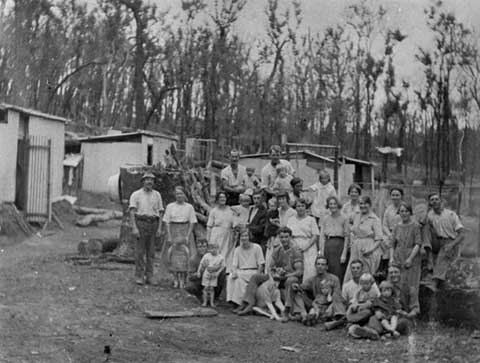|
The Group Settlement and Soldier Settmenet schemes were in fact two separate programs that operated after the end of World War One.
While the schemes were of similar intent and there was some overlapping and merging, it was to be the Soldier Settlement scheme that
had some success, while the Group Settlement scheme was a dismal failure.
The Soldier Settlement Scheme was aimed at getting returned servicemen into some form of gainful work while the Group Settlement
scheme was aimed at both increasing the population of W.A. and increasing primary production, especially dairy production.
Premier Sir. James Mitchell
is often credited with the origins of the idea but it was in fact Premier H.B. Lefroy who first proposed increasing the use of land
in the south west in 1915. Due to the war, it was not possible to implement any of the ideas and it was not until after the
end of the war that there was any real progress.
Mitchell was Premier when the schemes were formally implemented and he is credited with doing most of the work to things up and running.
He is also blamed (not without justification) for the abject failure of the Group Settlement scheme.
The state was spending huge sums of money importing food and needed to better supply its own needs and reduce the trade imbalance.
Britain, with a surplus of unskilled, mostly unemployed labour was keen to unload the unemployed and happily participated in the Group scheme
advertising the idea and even assisting with paid passages for migrants.
Group settlements started around the Manjimup area and spread to
Karridale,
Pemberton,
Northcliffe,
Denmark,
Busselton,
Margaret River and
Augusta.
Groups of up to 20 men (working under a foreman) were sent into the bush to clear campsites and make rough dwellings for families that would later follow.
Up to 160 acres was provided free of charge (except for surveying fees) to settlers who then worked as part of the group clearing and fencing land for a fixed wage.
Much like the original advertising for the initial settlement on the Swan River, the group settlement scheme was promoted in England with somewhat less than
accurate descriptions. Thousands applied to join the scheme and were to come out and live in corrugated iron shacks that were freezing in winter and boiling in summer.
Many people could not stand the conditions and simply walked away. 3,399 had arrived by 1924 but 1,172 gave up and left. By the late 1920s over 8
million pounds had been sunk into the scheme but it had been badly managed from the start. Eventually it became too much of a drain on the state's
resources and was abandoned in 1930.
Group Settlers may have been given ther land almost free of charge but other problems meant they did not fare as well in the end.
Many of the returned servicemen moved on to land that
had been re-purchased and they were expected to pay quite large sums for the land they worked. Group Settlers
were given unimproved land for as little as 1 pound but they were still expected to repay one third of the cost of their passage
from England, as well as loans for supplies etc.
The government provided a subsistance allowance but it was not enough to cover the costs of repayment, daily living and farm supplies.
The schemes were poorly planned, poorly funded and poorly managed.
Following is a description of the Group scheme that comes from Manjimup.
"The Group Settlement Scheme was set up by the West Australian Government after World War I to resettle returned soldiers and immigrants. Part of
the idea was to give Western Australia's rural economy a boost by opening up more land for agriculture.
Twenty families of Group 10 settled near One Tree Bridge. They lived in rough temporary huts provided by the Government until 25 acres of each family's
ballot-allocated 100 acres was partially cleared. Then they could move to their respective blocks and get down to the serious business of farming.
Clearing took 6 months, the bush was thick and the trees enormous. Most of the group settlers had no experience of farming and very little bushcraft.
With only crosscut saws and axes they were faced with clearing some of the worlds biggest trees from their land.
Many group settlers left, unable to handle the conditions and meet the repayments on their land and equipment and the loans they had to take out to
buy stores. Those that stayed the longest scratched out a living from dairy produce as they struggled to clear enough of their land to farm.
The Great Depression of the 1930s heralded the end of most of the Groupies. The price of butterfat collapsed and the
main source of income disappeared."
By 1927, the defecit in milk production had become a surplus with 8,000 gallons needed for local consumption and 20,000 gallons produced.
The government remained unsympathetic to the plight of the settlers and as families from England streamed in there was little
preparation for their accommodation and needs once they arrived.
The Soldier Settlement scheme generally produced better results than the Group Settlement scheme. This was partly due to better preparation
for that scheme. The Soldier settlers had good tents to move in to early on and cottages were completed quickly. They were not hampered
by silly rules and regualtions that meant they were free to seek temporary work outside the scheme itself. The Group settlers were not allowed
to work for wages and instead had to live on a subsistance payment from the scheme that they had to pay back along with all other encumbrances
along with 6.5% interest. If they had remained on their blocks for the rest of there lives, it is doubtful that would have ever managed to clear
their debts.
'Moo Cow' Mitchell (as he was called by many) was so focused on developing a dairy industry that he did not allow for diversification and
the Group settlers were hamstrung by the conditions imposed upon them.
When the Group Settlement Scheme was finally wound up, the state had lost close to 3 million pounds (one source quotes 6.5 million). Although seen as a failure it paved the way for
much of the abandoned land to be taken up again at the end of World War Two.
Following is a map of the group settlements in the Margaret River area. (courtesy Margaret River & Districts Historical Society)

|








